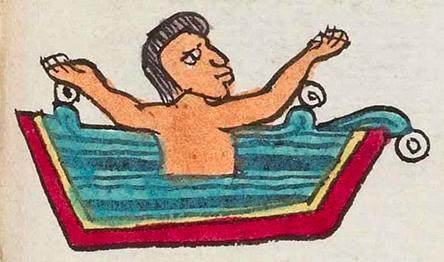Ahuilizapan (Mdz48r)
This compound glyph for the place name Ahuilizapan has two principal elements, a man standing in a structured water channel/canal (apantli) showing some pleasure [ahuiliztli) by raising his arms. The water in the apantli is spilling over the end on our right, which is not the norm for apantli, suggesting the possibility of enthusiastic play. The man appears to be naked, but we cannot see the lower half of his body. The trapezoidal apantli here has an exterior red lining and an interior yellow lining, shown in a cross-section view. The person can be identified as a man because of his short haircut, with bangs and the rest of his hair just below his ears. While his body is facing the viewer, his head is in profile view, facing to the viewer's right.
Stephanie Wood
Frances Karttunen sees āhuil- (enjoyment) and ā- (water) in the graphic elements, but for the reading of the place name she points to āhuiliz- ("the act of directing water," from āhuiā, "to wield water"). Thus, the graphic for pleasure is providing the phonetic dimension of water channeling and has no semantic role.
In some contexts, ahuiliztli indicates sexual pleasure, but this is difficult to assert here. Ahuiliztli, the personal name, is typically translated today as "Joy." There is also a Ballet Ahuiliztli and a preschool with this name today in Mexico, so the sexual component is not apparently paramount.
Stephanie Wood
ahuilizapan. puo
Ahuilizapan, pueblo
Stephanie Wood
c. 1541, but by 1553 at the latest
Stephanie Wood
Since the man appears to be half submerged and therefore inside the water, this is not really a front-to-back reading like so many glyphs with apantli.
irrigation ditch, channel, canal, waterway, playfulness, joy, fun, pleasure, leisure, water, canales, alegría, el ocio, riego, nombres de lugares

ahuiliz(tli), joy, pleasure, recreation, https://nahuatl.wired-humanities.org/content/ahuiliztli
apan(tli), water channel or canal, https://nahuatl.wired-humanities.org/content/apantli
pan(tli), furrow, https://nahuatl.wired-humanities.org/content/pantli
-apan (locative suffix), on or at the waters of, https://nahuatl.wired-humanities.org/content/apan-0
a(tl), water, https://nahuatl.wired-humanities.org/content/atl
-pan (locative suffix), on, https://nahuatl.wired-humanities.org/content/pan
"On the Irrigation Canals" (Karttunen apparently agrees with the Berdan and Anawalt translation.) [Frances Karttunen, unpublished manuscript, used here with her permission.]
"On the Irrigation Canals" (Berdan and Anawalt, 1992, vol. 1, p. 170)
Ahuiliz-āpan = "En las aguas alegres" (Miguel León-Portilla); o "En los canales de riego" (SW)
Miguel León-Portilla, "Los nombres de lugar en náhuatl," Estudios de Cultura Náhuatl 15 (1982), 43.
Codex Mendoza, folio 48 recto, https://digital.bodleian.ox.ac.uk/objects/2fea788e-2aa2-4f08-b6d9-648c00..., image 106 of 188.
The Bodleian Libraries, University of Oxford, hold the original manuscript, the MS. Arch. Selden. A. 1. This image is published here under the UK Creative Commons, “Attribution-NonCommercial-ShareAlike 3.0 License” (CC-BY-NC-SA 3.0).





